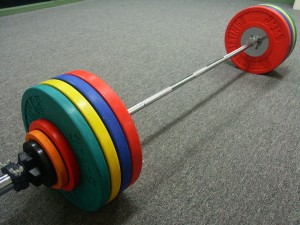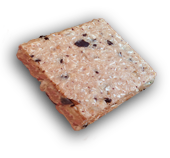 Thanks to the global “cult” of CrossFit, the discipline of Olympic Style Weight Lifting has been at the forefront of many fitness discussions lately. After CrossFit athlete Kevin Ogar’s horrific injury (severed spine/paralyzed below waist) during standard Crossfit lift in a recent competition, the risk versus reward debate about Olympic lifting has begun again.
Thanks to the global “cult” of CrossFit, the discipline of Olympic Style Weight Lifting has been at the forefront of many fitness discussions lately. After CrossFit athlete Kevin Ogar’s horrific injury (severed spine/paralyzed below waist) during standard Crossfit lift in a recent competition, the risk versus reward debate about Olympic lifting has begun again.
While I acknowledge that the injury to Ogar was a tragic accident, I also feel that it was totally avoidable. It was not the lift itself that causes the danger, but rather the improper usage of Olympic lifting in general. It is my opinion that CrossFit totally misinterprets and misuses Olympic lifting. In this blog, I will cover the “true” purpose of Olympic lifts, pre-requisites needed to execute an Olympic lift and contra indications to Olympic lifting.
What Is an Olympic Lift?
Olympic lifts are a group of highly complex and technique driven weight lifting movements including:
The Clean (including power and hang)
The Snatch (including power and hang)
The Jerk Press (including split and push press)
Purpose of Olympic Lifts:
Olympic lifts, as they’re called, have no equal for developing speed, flexibility, and coordinated, total-body strength, power and muscular size. Olympic lifters, on average, have the highest vertical leaps of all athletes. Ever wanted to dunk a basketball? This is what you need to be doing. Every single muscle in your body will be worked to lift more weight than you’ve ever lifted, in a much quicker fashion. Also, because you’re doing all of these exercises with such speed, you’re recruiting every Fast-Twitch muscle fiber, which has the greatest capacity for increased size and strength.
Four other reasons to perform Olympic lift:
Improved Cardiovascular System – Olympic lifts work the entire muscular system with a high-speed movement, this will skyrocket your heart rate and help build your anaerobic endurance.
Full Body Development – As the act of moving a barbell from the floor to overhead recruits every muscle in the body, you will see significant hypertrophy and strength gains throughout the body.
Minimized Overtraining with Weights – Meaning lifting weights that you cannot lift without assistance. With pure form Olympic lifts, there is no lifting partner to help finish a rep, or support from a bench, thus, there is very little ability to cheat or move excessive weight with poor form. Each lift needs to be executed correctly with good technique and speed, thus focus is on quality of movement, not quantity of reps or weight lifted.
Save Time – Olympic lifting routines are quick, A solid workout of 5-4-3-2-1 or twenty singles can take less than half hour. Working the entire body, as well as the cardiovascular system, the Olympic Lifts are very taxing so long sessions aren’t needed.
Contraindications for Olympic lifting:
It almost goes without saying that you shouldn’t attempt Olympic lifts if you’re currently injured. Past injuries can also influence whether Olympic lifts are a good idea for you or not. As a general rule, if you suffer from either of the next 2 injuries, skip Olympic lifting and train in a modality for gains with lower risk.
Neck Issues
Holding a load overhead — as you would in a snatch or push press — creates some of the highest cervical-spine compression forces one can produce in the weight room. So if you have any history of neck problems, I highly recommend avoiding overhead snatches and push presses. Cleans may or may not be a problem, consult a doctor if you’re unsure.
Lower Back Issues
If you’ve had past problems with your spinal discs or facets (the bone structures on the outer edges of your vertebrae that prevent spine-damaging movements), skip the Olympic lifts, unless you get an ‘OK’ from your doctor. The starting positions involve loaded trunk flexion, which is potentially dangerous for discs in lower back. Those with facet damage — usually from arthritis, an acute injury, or long-term wear and tear — will have trouble with the trunk extension at the end of each lift. (Quick test: If you can bend backwards at the waist without pain or limitations, you probably don’t have facet problems.) It’s possible to do lifts without pain even if you’ve had disc or facet injuries. But that doesn’t mean it’s a good idea, or that you’ll get benefits from these exercises you couldn’t get from alternative exercises with fewer risks.
How to Know If You’re Ready for Olympic Lifts:
Test #1: Shoulder Mobility
Stand with a neutral spine (in its natural arch, in other words). Lift your arms straight up as high as you can without changing your spinal alignment. This is a test of shoulder flexion in conjunction with thoracic extension. If you are unable to get your biceps just behind your ears without changing your spinal position, you lack shoulder mobility.
Test #2: Shoulder Impingement
The test to see if you have it is quick and simple: Stand or sit up straight with one hand on the opposite shoulder, then lift the elbow straight up, without lifting your hand off your shoulder. If you can do this without pain, you’re clear to do whatever you want in the weight room. If you do have pain or discomfort you have some degree of shoulder impingement.
Test #3: Hamstring Symmetry
This test of the functional range of movement available to your hamstrings is part of the Functional Movement Screen developed by Physical Therapist and forefather of modern training Gray Cook. http://graycook.com It’s important because the hamstrings play a major role in the triple extension mechanism of your ankle, knee, and hip joints that occurs during lifts. Lie on your back with a slab of wood or two five-pound plates under each thigh, lift one leg as high as possible without bending the knee or allowing your lower leg to come off the weight plates. Check both sides. We’re looking for symmetry here. It doesn’t matter if your hamstrings are tight, as long as both sides are equally tight. If one side is tighter than the other, it’s likely to cause unnecessary torque in your hips and lumbar spine when you lift anything from the floor.
Test #4: Hip Mobility
Before you do lifts from the floor, you need to be able to do the toe-touch squat with your spine in its neutral position. If you can’t, scratch floor-based lifts off your workout charts. You still might be able to do lifts from a hang position, depending on whether you can achieve the shortstop position with a neutral spine.
So if you fail any of the above mobility tests, SKIP the Olympic lifting until such time as you’ve corrected the issues through rehabilitative training and conditioning under the supervision of a trained Corrective Exercise Specialist or Physical Therapist.






